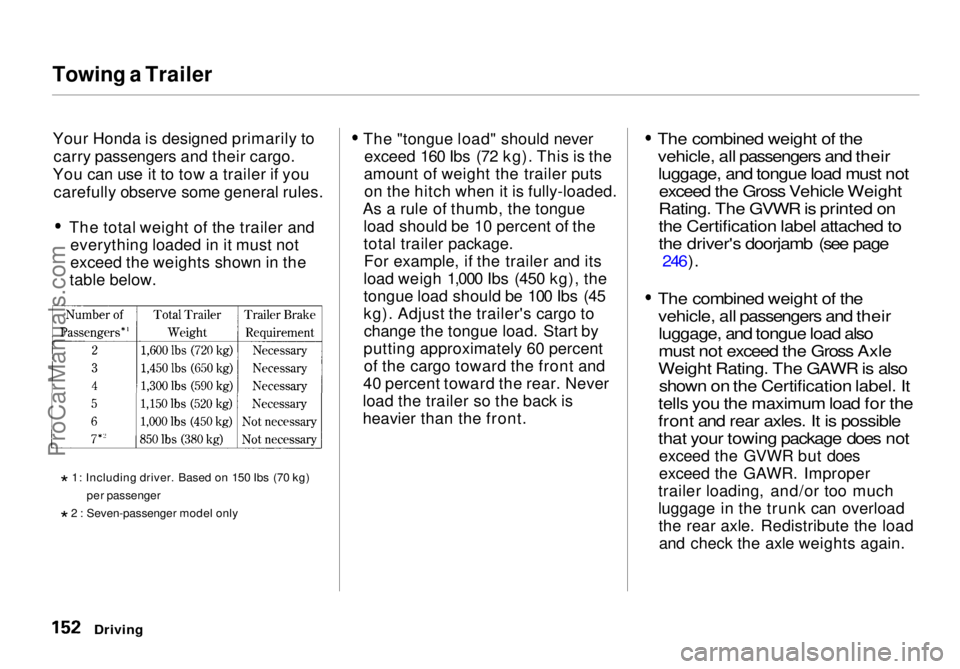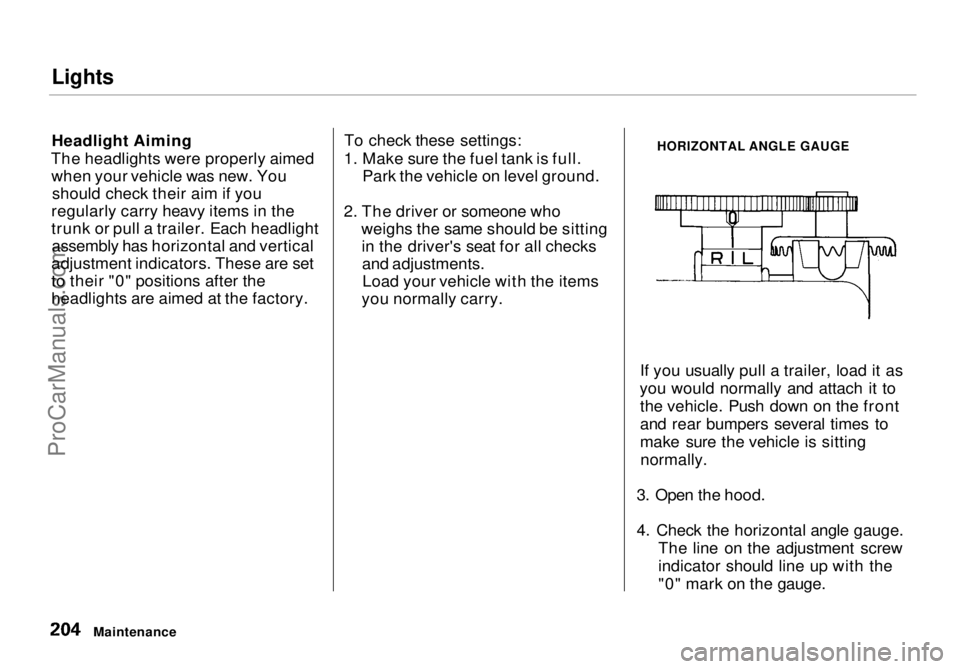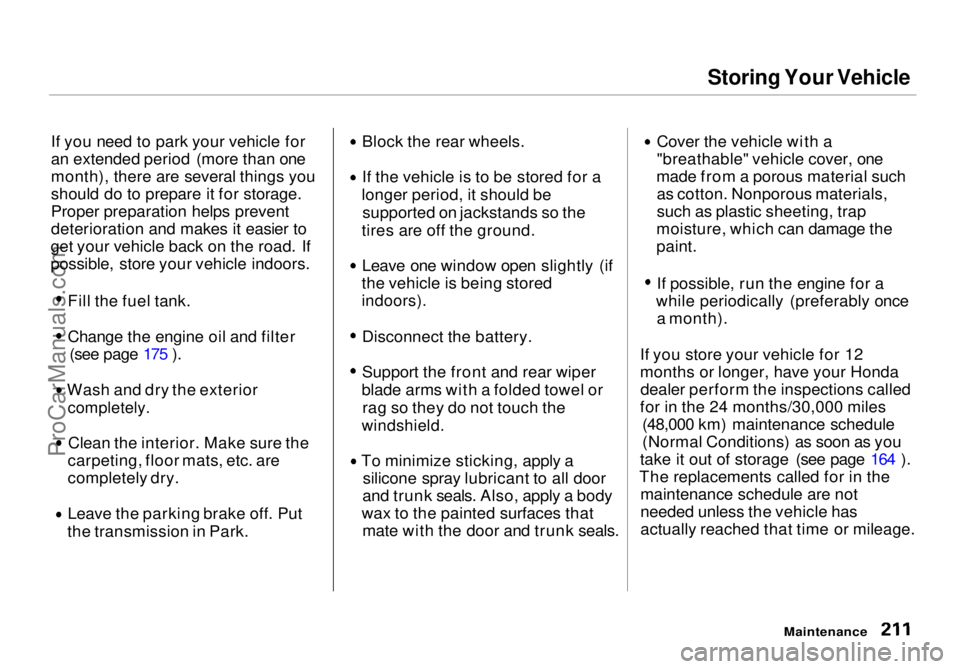trunk HONDA ODYSSEY 1998 Owners Manual
[x] Cancel search | Manufacturer: HONDA, Model Year: 1998, Model line: ODYSSEY, Model: HONDA ODYSSEY 1998Pages: 272, PDF Size: 2.67 MB
Page 152 of 272

Towing a Trailer
Your Honda is designed primarily to carry passengers and their cargo.
You can use it to tow a trailer if you carefully observe some general rules. The total weight of the trailer and
everything loaded in it must not
exceed the weights shown in the
table below.
* 1: Including driver. Based on 150 Ibs (70 kg)
per passenger
* 2 : Seven-passenger model only The "tongue load" should never
exceed 160 Ibs (72 kg). This is the
amount of weight the trailer puts on the hitch when it is fully-loaded.
As a rule of thumb, the tongue load should be 10 percent of the
total trailer package.For example, if the trailer and its
load weigh 1,000 Ibs (450 kg), the
tongue load should be 100 Ibs (45
kg). Adjust the trailer's cargo to change the tongue load. Start by
putting approximately 60 percent of the cargo toward the front and
40 percent toward the rear. Never
load the trailer so the back is
heavier than the front.
The combined weight of the
vehicle, all passengers and theirluggage, and tongue load must not exceed the Gross Vehicle Weight
Rating. The GVWR is printed on
the Certification label attached to
the driver's doorjamb (see page
246).
The combined weight of the vehicle, all passengers and theirluggage, and tongue load also
must not exceed the Gross Axle
Weight Rating. The GAWR is also shown on the Certification label. It
tells you the maximum load for the
front and rear axles. It is possible
that your towing package does not
exceed the GVWR but does
exceed the GAWR. Improper
trailer loading, and/or too much
luggage in the trunk can overload the rear axle. Redistribute the loadand check the axle weights again.
DrivingProCarManuals.comMain Menu Table of Contents s t
Page 203 of 272

Lights
Headlight Aiming
The headlights were properly aimed when your vehicle was new. You should check their aim if you
regularly carry heavy items in the
trunk or pull a trailer. Each headlight assembly has horizontal and vertical
adjustment indicators. These are set
to their "0" positions after the
headlights are aimed at the factory. To check these settings:
1. Make sure the fuel tank is full. Park the vehicle on level ground.
2. The driver or someone who weighs the same should be sittingin the driver's seat for all checksand adjustments.Load your vehicle with the items
you normally carry.
HORIZONTAL ANGLE GAUGE
If you usually pull a trailer, load it as
you would normally and attach it to the vehicle. Push down on the front
and rear bumpers several times to
make sure the vehicle is sittingnormally.
3. Open the hood.
4. Check the horizontal angle gauge. The line on the adjustment screw
indicator should line up with the
"0" mark on the gauge.
MaintenanceProCarManuals.comMain Menu Table of Contents s t
Page 210 of 272

Storing Your Vehicle
If you need to park your vehicle for
an extended period (more than one
month), there are several things you
should do to prepare it for storage.
Proper preparation helps prevent
deterioration and makes it easier to
get your vehicle back on the road. If
possible, store your vehicle indoors.
Fill the fuel tank.
Change the engine oil and filter(see page 175 ). Wash and dry the exterior
completely.
Clean the interior. Make sure the
carpeting, floor mats, etc. are
completely dry. Leave the parking brake off. Put
the transmission in Park. Block the rear wheels. If the vehicle is to be stored for a
longer period, it should be supported on jackstands so the
tires are off the ground.
Leave one window open slightly (if
the vehicle is being stored
indoors).
Disconnect the battery.
Support the front and rear wiper
blade arms with a folded towel or rag so they do not touch the
windshield.
To minimize sticking, apply a
silicone spray lubricant to all door
and trunk seals. Also, apply a body
wax to the painted surfaces that mate with the door and trunk seals. Cover the vehicle with a
"breathable" vehicle cover, one
made from a porous material such as cotton. Nonporous materials,
such as plastic sheeting, trap
moisture, which can damage the
paint. If possible, run the engine for a
while periodically (preferably once a month).
If you store your vehicle for 12
months or longer, have your Honda dealer perform the inspections called
for in the 24 months/30,000 miles (48,000 km) maintenance schedule
(Normal Conditions) as soon as you
take it out of storage (see page 164 ).
The replacements called for in the maintenance schedule are not
needed unless the vehicle has
actually reached that time or mileage.
MaintenanceProCarManuals.comMain Menu Table of Contents s t